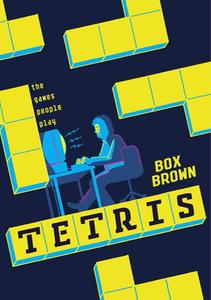
 Box Brown, author and illustrator of the graphic biography Andre the Giant: Life and Legend, turns his attention to the complicated history of one of the greatest video games ever made in Tetris: The Games People Play. Brown's cartoonish art style--distinctive in its eye-catching black-and-yellow color palette--allows him to break down into accessible pieces thorny topics such as game theory, the psychology of gaming, copyright law and the byzantine bureaucracy of the Soviet Union, Tetris's home country.
Box Brown, author and illustrator of the graphic biography Andre the Giant: Life and Legend, turns his attention to the complicated history of one of the greatest video games ever made in Tetris: The Games People Play. Brown's cartoonish art style--distinctive in its eye-catching black-and-yellow color palette--allows him to break down into accessible pieces thorny topics such as game theory, the psychology of gaming, copyright law and the byzantine bureaucracy of the Soviet Union, Tetris's home country.
Brown starts with Alexey Pajitnov, a computer scientist at the Moscow Academy of Science. Pajitnov created Tetris in his spare time on an Elektronika 60, a now-ancient computer that lacked graphical capabilities. So Pajitnov used text characters to sketch out a primitive but essentially complete version of the game, passing it around to his colleagues on floppy discs.
Tetris became a viral phenomenon in the Soviet Union and, eventually, a global success based on its simple, yet timeless, gameplay. In explaining Tetris's appeal, Brown's choice of a visual medium is very handy. According to Brown, "Alexey had tapped into something in the brain. The nature of the gameplay causes the player's pre-frontal cortex to be stimulated constantly. People remained motivated to continue to play on and on." The game's addictiveness, in other words, is founded in neurochemistry: tasks create tension in the brain, tension that releases once the task is finished. Brown compares this elasticity to stretching a rubber band, and illustrates the concept with diverse examples, including an anecdote about wait staff in a 1960s Vienna pub.
Brown also goes back much further than Tetris's humble origin, exploring theories behind the development of gaming in early human history. He explains how the twin urges to compete and to play were merged by artists to create simple dice games and more sophisticated games, such as the ancient Egyptian board game Senet. Tetris: The Games People Play is not just an account of a single game; it's an exploration of gaming as a human phenomenon. Brown works hard to position gaming in the same realm as artistry, depicting creators as artists and Tetris as a timeless work of art.
Brown provides warm, humanistic sketches (in the literal and figurative sense) of the many, many players involved in the game's popularization. The Soviet Union's complicated relationship with Western commercial interests and the rivalry between Nintendo and Atari, titans of early video gaming, led to an all-out war over the rights to Tetris. Instead of getting mired in endless business dealings and dry legalese, however, Brown focuses on the various colliding personalities involved in the struggle. This is an ambitious work of history in graphic novel form. It approaches the world-conquering game as a dopamine delivery system, a lucrative product and, above all else, an artistic triumph. --Hank Stephenson, bookseller, Flyleaf Books
Shelf Talker: Tetris: The Games People Play is a graphic history of one of the most popular video games of all time as well as a celebration of gaming as an artistic medium.

